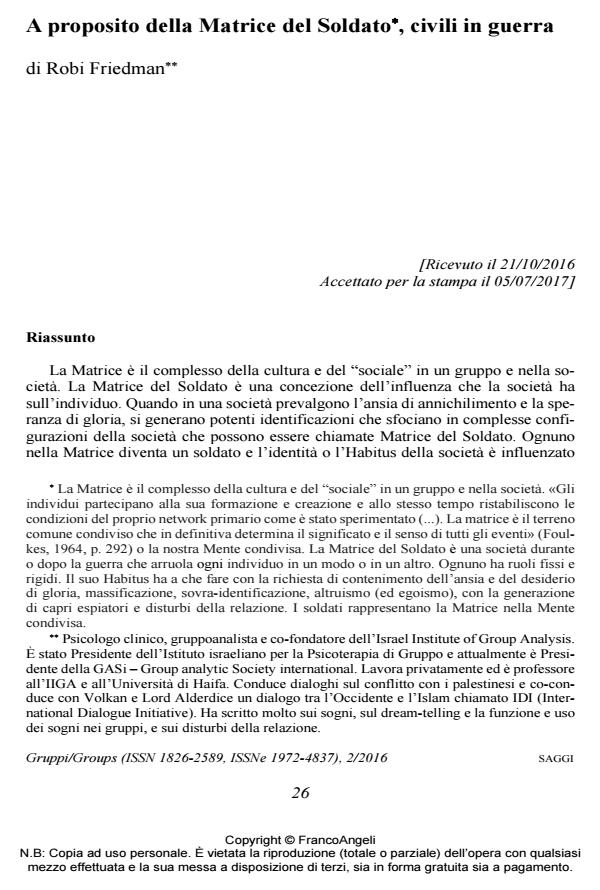Relating in the Soldiers’ Matrix, Civilians at war
Journal title GRUPPI
Author/s Robi Friedman
Publishing Year 2017 Issue 2016/2
Language Italian Pages 10 P. 26-35 File size 147 KB
DOI 10.3280/GRU2016-002003
DOI is like a bar code for intellectual property: to have more infomation
click here
Below, you can see the article first page
If you want to buy this article in PDF format, you can do it, following the instructions to buy download credits

FrancoAngeli is member of Publishers International Linking Association, Inc (PILA), a not-for-profit association which run the CrossRef service enabling links to and from online scholarly content.
The Matrix is the whole of the Culture and "social" in a group and Society. The Soldiers’ Matrix is a perspective on Society’s influence on the individual. Powerful identifications in times of annihilation anxieties and hopes for Glory result in complex societal figurations which may be called "Soldiers’ Matrix". Everybody in the matrix becomes a soldier, and the identity or the "Habitus" of the society is influenced by the unconscious Selfless aspects of soldiership. In the Soldiers’ Matrix, citizens are meant to hand themselves over to Society, surrender their Minds as well as their bodies. Men should clearly become some kind of soldiers, women clearly by forgetting their own personal development in favor of pregnancy and if possible motherhood of soldiers. The Group Analytic Large Group provides a space where on the one hand the "social Self" is active and on the other hand it is the only possible space to work on the strong social feelings: annihilation anxieties, hopes for Glory, de-identification and separation from your own Matrix and. It promotes the best possibilities to practice containment of conflicts and coping with massive authority and other significant processes.
Keywords: Soldiers’s Matrix, Society, Group analysis, Relation disorders, Sandwich model, Large Group
- Osservare i Large Group online ai tempi della pandemia: esperienze in transito verso nuovi paradigmi Nadia Benedetto, Valentina Borla Cart, Ludovica Cavuoti, Marisol Falcone, Marta Gianaria, Sarah Minetti, Alice Mulasso, Maria Pace, Simonetta Travaglini, in GRUPPI 2/2023 pp.179
DOI: 10.3280/gruoa2-2021oa15816
Robi Friedman, A proposito della Matrice del Soldato, civili in guerra in "GRUPPI" 2/2016, pp 26-35, DOI: 10.3280/GRU2016-002003